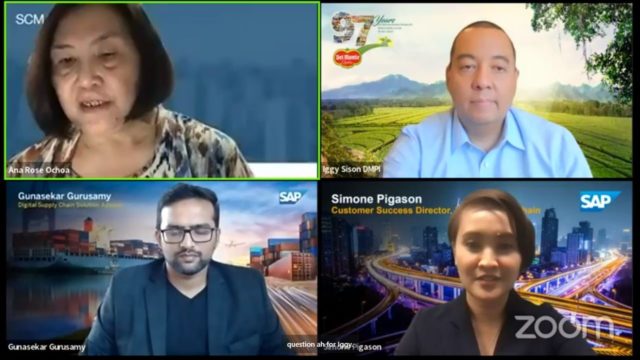
MANILA, Philippines — Sustainability has become a necessity for organizations in today’s world as more consumers seek sustainable brands, investors consider environmental, social, and governance (ESG) initiatives for investment decisions, and governments increase their regulations.
A recent report by Kyndryl revealed that 77 percent of Southeast Asian businesses are concentrating on ESG initiatives. One of the growing efforts made by organizations involves mostly the decarbonization of their supply chains. According to the UNGC-Accenture CEO study, 60 percent of carbon emissions worldwide come from organizations’ supply chains.
In a virtual event conducted by the Supply Chain Management Association of the Philippines (SCMAP) in partnership with SAP SE (NYSE: SAP), titled “Enabling Sustainable Supply Chains”, SAP leaders, joined by Del Monte Philippines, shared how to reduce emissions in the supply chain and leverage data and technology to achieve sustainability goals.
Decreasing Emissions on the Three Scopes
Companies’ carbon emissions are divided into three scopes. This includes Scope 1, which is emissions from businesses’ own operations; Scope 2, which involves emissions from purchased utilities from third parties like electricity; and Scope 3, which covers all the other emissions in the entire value chain. This ranges from employee commute to consumer behavior when using the company’s products, among others.
During the event, Iggy Sison, Chief Sustainability Officer of Del Monte Philippines, imparted the brand’s initiatives to realize a net zero carbon emissions goal in the three scopes. “The company is now shifting third-party delivery transport to double-decker trucks to reduce emissions. Aside from that, our goal is to decrease emissions at our production facility by 3 percent per year, install solar power in our plant and plantation, expand measurement to include Scope 3 emissions, and more.”
Leveraging Data and Technology for a Clear Path Forward
However, for businesses to have a clear sustainability journey, Simone Pigason, Head of the Digital, Resilient, and Sustainable Supply Chain of SAP Southeast Asia, remarked that organizations need to address three key challenges. “Organizations must first have the ability to record their ESG data across the entire value chain to measure and ensure progress. Then, they need a robust platform that can cater to reporting needs across diverse regulatory bodies and frameworks. And finally, they must use different solutions to embed the insights gathered from the datasets into the business processes.”
Pigason then added, “Data enables businesses to forecast demand accurately to avoid unnecessary waste, especially with supply chain disruptions. Aside from increasing carbon emissions, overproduction can cause additional warehouse inventory, spoilage, and more.”
Developing Sustainable Supply Chains Now and In the Future
To help businesses kickstart their sustainability journey, Sison shared that organizations must first define their stakeholders, such as consumers, employees, and investors, among others. “After identifying these elements, companies need to determine what is a key concern for these stakeholders and prioritize the things to address. That is an important process to ensure that the sustainability initiatives are relevant, responsive, and proactive,” he added.
Meanwhile, Pigason encouraged companies to continue the conversation about sustainability in supply chains. “Talking more about sustainability can expand discussions from Scope 1 and 2 to 3. Businesses will also know where their baseline and where to start in the three scopes,” she added.
Rudy Abrahams, Managing Director of SAP Philippines, agreed on how organizations can begin developing sustainable supply chains. He emphasized the significance of sustainability now and in the future to businesses. “Sustainability can improve organizations’ profitability because businesses are reducing emissions, energy costs, and more to help the planet. Aside from that, it also helps in increasing brand value for shareholders, customers, and even employees while adhering to regulatory compliance and improving ancillary revenue streams.”
To assist businesses in strengthening their sustainability initiatives, SAP has been offering solutions like the Sustainability Navigator Tool. This solution helps businesses identify their sustainability challenges in three dimensions. This includes climate action, circular economy, and even social responsibility. It also provides solutions that can help organizations address the challenges using specific toolsets.
Visit the SAP News Center. Follow SAP on Twitter at @SAPNews.
About SAP
SAP’s strategy is to help every business run as an intelligent, sustainable enterprise. As a market leader in enterprise application software, we help companies of all sizes and in all industries run at their best: SAP customers generate 87% of total global commerce. Our machine learning, Internet of Things (IoT), and advanced analytics technologies help turn customers’ businesses into intelligent enterprises. SAP helps give people and organizations deep business insight and fosters collaboration that helps them stay ahead of their competition. We simplify technology for companies so they can consume our software the way they want – without disruption. Our end-to-end suite of applications and services enables business and public customers across 25 industries globally to operate profitably, adapt continuously, and make a difference. With a global network of customers, partners, employees, and thought leaders, SAP helps the world run better and improve people’s lives. For more information, visit www.sap.com.




